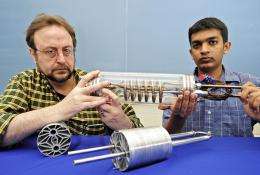Engineers design, build major component for hydrogen cars

(PhysOrg.com) -- Researchers have completed work on a crucial component for an experimental hydrogen storage system for cars, part of efforts to reduce pollution and the use of fossil fuels in transportation.
The system uses a fine metal powder to absorb hydrogen gas under high pressure. When the powder absorbs hydrogen, it becomes a "metal hydride," and the process is called "hydriding." By then decreasing the pressure in the vessel or warming the metal hydride, the hydrogen can be released to drive a fuel cell or engine.
A complication in perfecting the technology, however, is that the hydriding process generates heat, which hinders the absorption process and prevents the hydrogen storage vessel from being filled rapidly, said Issam Mudawar, a Purdue University professor of mechanical engineering who is leading the work with research assistant professor Timothée Pourpoint and doctoral student Milan Visaria.
"If you're driving your hydrogen car, you can't wait an hour at the filling station," Mudawar said. "For this system to be practical, you have to be able to cool the hydride efficiently so that the storage vessel can be filled within five minutes with enough fuel to drive 300 miles."
The researchers have made progress in solving the problem by designing, building and testing the system's heat exchanger and circulating coolant through tubes to remove heat and speed hydrogen storage, Mudawar said.
The engineers filed a final patent in February for the heat exchanger, a coil of stainless steel tubing that fits inside a hydrogen storage "pressure vessel" 4 inches in diameter. Standard automotive coolant is circulated through the tubing.
Such a storage technology could help make hydrogen cars a reality if other researchers are successful in developing improved alloys for hydriding and better fuel cells, which generate electricity to power an electric motor. The hydrogen also could be burned instead of gasoline in internal combustion engines.
Due to space constraints, it is essential that the heat exchanger occupy the least volume possible inside the storage vessel. Using a theoretical model they developed, the researchers determined how to precisely position the tubing so that no fins are needed to dissipate heat.
Eliminating the fins reduces the cost, weight and size of the heat exchanger, Mudawar said.
The researchers designed a system that occupies the least space possible while also properly cooling the hydride. Whereas an earlier prototype occupied 30 percent of the vessel, leaving 70 percent for the metal hydride, the new design occupies 7 percent, leaving 93 percent for the hydride.
"The idea behind this latest design is to provide the coolant as close as possible to the hydride while eliminating the need for bulky heat spreading components like fins," Mudawar said. "The main advantages of this design are simplicity and flexibility. It can easily be adapted depending on cooling and size requirements."
Provided by Purdue University


















